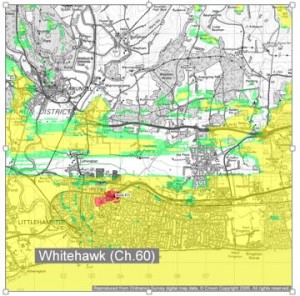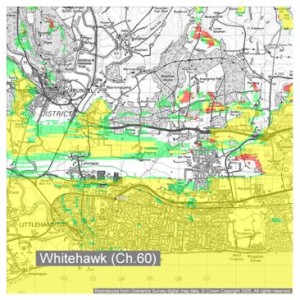The study analysed the possibility of repairing holes caused by base station transmitters in digital TV coverage areas by deploying repeaters. The approach was based on co-locating a small TV ‘booster’ transmitter at any interfering base station. The aim was to increase the available TV signal in the area to an extent sufficient to protect it from interference. As the two transmissions would be from the same location, their strength would vary in unison across the coverage area, thus preserving the required protection ratio.
As a ‘real world’ illustration, a hypothetical ECN base station was modelled at the edge of the Whitehawk Hill DTT service area (30 km from the DTT transmitter). It was planned to use channel 60 for DTT post-switchover at Whitehawk Hill. Using our interference modelling tool the impact of the base station was identified as shown by the figure below which shows the DTT service area for 70% and 90% pixel coverage (green & yellow shading), with the punched hole shown in red.

It was found that it was possible to repair the ‘punched hole’, as shown below, by rebroadcasting a DTT signal that has the correct power relative to the interfering transmitter to give the required DTT protection ratio. In this case the interference is corrected using a 1W DTT on-channel repeater.

